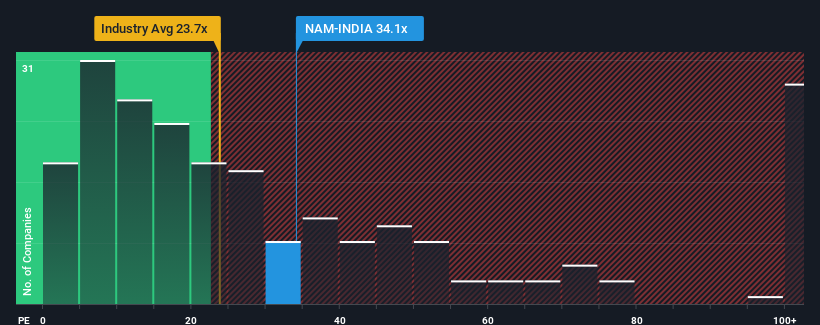- India
- /
- Capital Markets
- /
- NSEI:NAM-INDIA
There's Reason For Concern Over Nippon Life India Asset Management Limited's (NSE:NAM-INDIA) Price

It's not a stretch to say that Nippon Life India Asset Management Limited's (NSE:NAM-INDIA) price-to-earnings (or "P/E") ratio of 34.1x right now seems quite "middle-of-the-road" compared to the market in India, where the median P/E ratio is around 32x. However, investors might be overlooking a clear opportunity or potential setback if there is no rational basis for the P/E.
Nippon Life India Asset Management certainly has been doing a good job lately as it's been growing earnings more than most other companies. One possibility is that the P/E is moderate because investors think this strong earnings performance might be about to tail off. If not, then existing shareholders have reason to be feeling optimistic about the future direction of the share price.
Check out our latest analysis for Nippon Life India Asset Management

Does Growth Match The P/E?
There's an inherent assumption that a company should be matching the market for P/E ratios like Nippon Life India Asset Management's to be considered reasonable.
If we review the last year of earnings growth, the company posted a terrific increase of 37%. The strong recent performance means it was also able to grow EPS by 81% in total over the last three years. Accordingly, shareholders would have probably welcomed those medium-term rates of earnings growth.
Looking ahead now, EPS is anticipated to climb by 12% during the coming year according to the nine analysts following the company. Meanwhile, the rest of the market is forecast to expand by 24%, which is noticeably more attractive.
In light of this, it's curious that Nippon Life India Asset Management's P/E sits in line with the majority of other companies. Apparently many investors in the company are less bearish than analysts indicate and aren't willing to let go of their stock right now. These shareholders may be setting themselves up for future disappointment if the P/E falls to levels more in line with the growth outlook.
The Key Takeaway
Typically, we'd caution against reading too much into price-to-earnings ratios when settling on investment decisions, though it can reveal plenty about what other market participants think about the company.
We've established that Nippon Life India Asset Management currently trades on a higher than expected P/E since its forecast growth is lower than the wider market. Right now we are uncomfortable with the P/E as the predicted future earnings aren't likely to support a more positive sentiment for long. This places shareholders' investments at risk and potential investors in danger of paying an unnecessary premium.
We don't want to rain on the parade too much, but we did also find 2 warning signs for Nippon Life India Asset Management that you need to be mindful of.
If P/E ratios interest you, you may wish to see this free collection of other companies with strong earnings growth and low P/E ratios.
Valuation is complex, but we're here to simplify it.
Discover if Nippon Life India Asset Management might be undervalued or overvalued with our detailed analysis, featuring fair value estimates, potential risks, dividends, insider trades, and its financial condition.
Access Free AnalysisHave feedback on this article? Concerned about the content? Get in touch with us directly. Alternatively, email editorial-team (at) simplywallst.com.
This article by Simply Wall St is general in nature. We provide commentary based on historical data and analyst forecasts only using an unbiased methodology and our articles are not intended to be financial advice. It does not constitute a recommendation to buy or sell any stock, and does not take account of your objectives, or your financial situation. We aim to bring you long-term focused analysis driven by fundamental data. Note that our analysis may not factor in the latest price-sensitive company announcements or qualitative material. Simply Wall St has no position in any stocks mentioned.
About NSEI:NAM-INDIA
Nippon Life India Asset Management
Nippon Life Asset Management Limited is a publicly owned investment manager.
Outstanding track record with flawless balance sheet.
Similar Companies
Market Insights
Community Narratives



